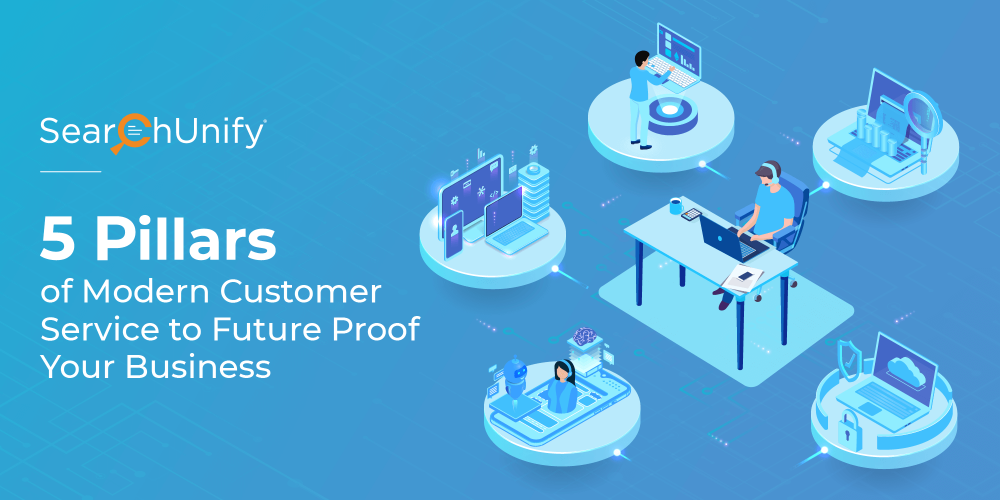
This year made sure that digital transformation didn’t remain a ‘bandwagon’ to jump on but the default option of companies. Many brands have pivoted themselves to meet short-term survival goals. But to be part of the long game means building resilient customer service that keeps experience–customer and employee–at the core. Are we still concerned about the experience? Well, yes.
Harvard Business Review observed that businesses, even established ones, face threats due to customers’ increased willingness to experiment with different offerings during the crisis. Reminds me of a quote, The whale is endangered, while the ant continues to do just fine. Customers are expecting more from brands than previously and becoming interested in safety, experience, and comfort. In this blog post, we look at the five pillars of modern customer service that will future-proof your business, no matter which industry you’re from.
1. Connected Channels for Unified Customer Engagement
Customers connect with a brand on a variety of channels ranging from social media, email, website, mobile app, voice response system, to online chat. All these channels should be connected to provide a unified CX. That is, if a customer raises an issue on, let’s say, Twitter and calls your customer service the next day to follow up, your representative should already know about it. Asking customers to narrate their story again will push them over the edge.
Cognitive search discards siloed service infrastructure by unifying all the channels to provide a cohesive, omnichannel experience. It integrates your CRM with the support platform and knowledge bases so that agents can view the entire customer journey and provide answers on the fly. To add a cherry on the cake, it also makes it easy to find subject matter experts to facilitate hand-off from one agent (or department) to another.
2. Fluid and Intuitive Self-Service Models
From resolving just break-fix issues to answering procedural queries, customer self-service portals have come a long way. Self-service is poised to get even more dominant in the future. If you already have self-service platforms, you can upgrade them to be more efficient.
For instance, you can employ chatbots that are AI-powered and leverage natural language processing (NLP) to take care of L1 queries. They are based on a cognitive search framework and unsupervised learning, which reduce the required training time, administration, and maintenance. They understand query intent and deliver highly relevant results. If you want to dive deeper into this topic, this handy ebook will help.
Online communities that have been successful in bringing down support costs and increasing case deflection leverage intuitive UI and dynamic content display. They also have powerful search engines that learn from user search history and click behavior to surface increasingly relevant results and recommendations. You need to break the fourth wall to provide next-gen self-service to your customers.
3. AI-Powered Apps for Agents to Provide Modern Support
According to the Salesforce State of Service Report, 71 % of agents see their role as more strategic than two years ago. They have to solve complex issues, personalize each customer interaction, and in some cases, upsell or cross-sell as well. You can’t expect your service agents to do all this with outdated technology. That’s like expecting someone to win the Olympics barefoot; not everyone is Abebe Bikila!
Hence, you need to provide them the right set of tools that augment their productivity. Many AI-powered apps that help speed things up by curating a list of top relevant KB articles, analyze various aspects of a ticket such as customer sentiment, type of query, etc., to provide the likelihood of escalation and much more. All you need to do is explore. You can start here.
4. Scalable and Privacy Enhancing Solutions
When you’re thinking about investing in solutions to upgrade your customer service, make sure that they’re easily scalable. The reason being your user base and enterprise content will continue to grow. Cognitive search engines can manage billions of documents. However, this scalability often requires a sophisticated configuration. An ideal search solution takes care of this and doesn’t require third-party integrations.
While making more information easily accessible, data security becomes quite a challenge. A good cognitive search platform should handle transactions over HTTPS & TLS layers for the integrity of in-transit data and offer security standards of the highest degree.
[Also Read Blog Post: 8 Key Considerations for Enterprise Search Security]
5. Insights Engine for Data-Driven Pivoting
Last but not least, analytics that let you tweak your online properties for the best experiences are of profound importance. Cognitive search offers real-time insights and discovers content gaps. That helps create knowledge-based assets for frequently asked questions to heighten engagement on your platforms.
A plethora of user-friendly reports track user activities and search trends to give you a one-stop dashboard to analyze multiple metrics at once. Measure, interpret, and evolve your customer service strategy at regular periods to stay up-to-date.
Need Help to Navigate the Confusing Cognitive Search Marketplace for Improving Customer Service?
Zeroing in on the right search solution for your business can be a daunting task. Here’s a comprehensive guide that will make it a breeze to evaluate solution capabilities & save you a lot of time.



















